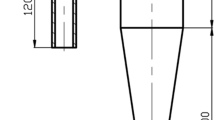Abstract
Existing design equations can hardly provide reliable guidance in hydrocyclone designs and give explanations for the selected optimum range of spiral tube inlet. In this paper, the spiral tube inlet hydrocyclone for offshore oil-water separation was optimized by using the response surface method and multi-objective optimization method. With optimization results which were verified by numerical simulation and experiments discussed and analyzed, the optimal entrance structural parameters were obtained: d = 7.45 mm; D = 32.50 mm; h = 7.80 mm; C = 2.00, and the separation efficiency of the optimized hydrocyclone was increased by 8.34% and Euler number reduces 4.12. The optimization process show that the response surface method is reliable for the optimization of the inlet structure of the spiral tube, which provides technical guidance for the development and optimization of the sea oil produced water treatment equipment.
Access this chapter
Tax calculation will be finalised at checkout
Purchases are for personal use only
Similar content being viewed by others
References
Das, T., Preben, F.T., et al.: Modelling and optimization of compact subsea liquid-liquid separation system. In: 26th European Symposium on Computer Aided Process Engineering, pp. 1255–1260 (2016)
Das, T., Heggheim, S.J., et al.: Optimal operation of a subsea separation system including a coalescence based gravity separator model and a produced water treatment section. Ind. Eng. Chem. Res. 58, 4168–4185 (2019)
Bing, L., Huajian, W., et al.: Study of GRL and inlet velocity on hydrocyclone for fracturing flow-back fluids. Math. Probl. Eng. 12, 1–2 (2019)
Changjun, L., Qian, H.: Analysis of droplet behavior in a de-oiling hydrocyclone. J. Dispersion Sci. Technol. 317–327 (2016)
Nenu, R., Yoshida, H.: Comparison of separation performance between single and two inlets hydrocyclones. Adv. Powder Technol. 20(2), 195–202 (2009)
Bing, L., Luncao, L., Huajian, W., et al.: Numerical simulation and experimental study on internal and external characteristics of novel Hydrocyclones. Heat Mass Transf. (17) (2020)
Peikun, L., Huajian, W., et al.: Effect of gas–liquid ratio on the performance of hydrocyclones for desanding flowback fracturing fluids. Nat. Gas. Ind. 39(11), 44–54 (2019)
Xu, P., Wu, Z., Mujumdar, A.S., et al.: Innovative hydrocyclone inlet designs to reduce erosion-induced wear in mineral dewatering processes. Drying Technol. 27(2), 201–211 (2009)
Noroozi, S., Hashemabadi, S.: CFD analysis of inlet chamber body profile effects on de-oiling hydrocyclone efficiency. Chem. Eng. Res. Des. 89(7), 968–977 (2011)
Qiaoduo, Y.: Numerical simulation of oil-water separation and droplet breakage in Hydrocyclone. Huazhong University of science and technology, Wuhan, pp. 26–50 (2014)
Abdul, M.: Theoretical and numerical study of swirling flow separation devices for oil-water mixtures. Michigan State University, Michigan State, pp. 24–30 (2015)
Box, G., Wilson, K.: On the experimental attainment of optimum conditions. J. R. Stat. Soc. Ser. B 13, 1–45 (1951)
Tang, B., Xu, Y., et al.: Numerical study on the relationship between high sharpness and configurations of the vortex finder of a hydrocyclone by central composite design. Chem. Eng. J. 278, 504–516 (2015)
Acknowledgment
This study was financially supported by the National Natural Science Foundation of China (Grant No. 51804183).
Author information
Authors and Affiliations
Corresponding author
Editor information
Editors and Affiliations
Rights and permissions
Copyright information
© 2021 The Author(s), under exclusive license to Springer Nature Singapore Pte Ltd.
About this paper
Cite this paper
Wu, Z. et al. (2021). Parameter Optimization of Hydrocyclone at the Inlet of Spiral Tube for Offshore Oil Water Separation. In: Wang, Y., Martinsen, K., Yu, T., Wang, K. (eds) Advanced Manufacturing and Automation X. IWAMA 2020. Lecture Notes in Electrical Engineering, vol 737. Springer, Singapore. https://doi.org/10.1007/978-981-33-6318-2_7
Download citation
DOI: https://doi.org/10.1007/978-981-33-6318-2_7
Published:
Publisher Name: Springer, Singapore
Print ISBN: 978-981-33-6317-5
Online ISBN: 978-981-33-6318-2
eBook Packages: Intelligent Technologies and RoboticsIntelligent Technologies and Robotics (R0)




